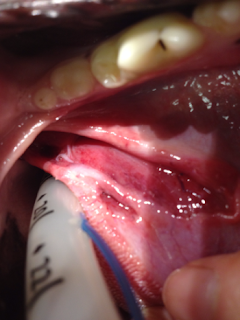“You know I wouldn’t ask if I wasn’t desperate, but no-one will help him and his fish will die. Is there anything you could do?”
I took a long slow breath. “Okay, I can’t promise anything, it’s really not my area, but I can talk to him. Text me his number and I’ll call in the morning”. I hung up with a feeling of doom. I always worry when personal and work life collide. My soft hearted mate was lobbying on behalf of a friend of his who was a Koi carp enthusiast. He had spent all his spare time and money investing in special ponds and filtration systems to look after a handful of these friendly big fish. Now one of them was sick, and he couldn’t find a vet to treat them. His local vets all gave him the brush off saying they don’t treat fish. The fish vets out on the coast wanted to charge him an arm and a leg to do a full inspection including travel cost, full day consultation fee plus drugs, running to hundreds of pounds. They weren’t able to find that much cash at short notice having maxed out on setting up the facilities. He was getting desperate, and with every set back the infection was gaining ground, untreated for longer.
“Hello is that Paul? I’m Ranjit’s friend, Heather the Vet. He says you’ve got a problem you need a hand with? “
Over the course of the next 10 minutes Paul told me all about his fish, not in abstract terms but as individual characters who had likes and dislikes, different personalities. He was clearly besotted. He had been caring for Koi for 8 years, learning as much as he could and giving them the best life possible. But now his favourite, Big Momma was sick. A minor scrape on her side had become infected and was spreading rapidly, killing off the scales on that side, affecting the muscle and causing pain and suffering. I didn’t want to get involved, but neither did anybody else and I wasn’t going to let this animal suffer just because it was inconvenient. His final sign off clinched the deal:
“She’s my favourite fish and we love her very much. Please help us?”
In order to legally diagnose, treat and prescribe for Big Momma I had to officially register the fish as being under my care. We started by getting as many details as possible – the basics like name and address, then moving on to fish names, lengths, ages and weights. I needed as much information as possible. Next I wanted to see the lesions on Big Mommas side to assess the damage and also to chart progress. I asked for a set of photographs to be taken. Whilst I waited for Paul to email me with all the information I needed I did a little research about the best treatment for problems like this. I was delighted to discover that the most effective (and crucially, licensed) treatment is a relatively common drug that I had sitting on the shelf. All I had to do was dispense a five day course of antibiotic at 14milligrams per kilo of fish, and supply the equipment to inject the fish once daily.
My phone pinged; Paul’s email had arrived and I could see the problem myself for the first time. The poor girl had an extensive infection causing necrosis of the skin and loss of scales. The raw flesh underneath was poking out. Based on the measurements I worked out the appropriate dose and ran to the post office – this fish needed the drugs by tomorrow or it might be too late.
 |
| The infection spreading |
Over the following week I checked in regularly to see how Big Momma was getting on, and for days she seemed to stay the same – no spreading infection but not getting better either. And then, suddenly, a shift. The dead scales were still getting pushed out but instead of raw flesh underneath there was healthy granulation tissue. She was fighting back, making a scar.
 |
| The infection stopped, dead tissue sloughing and nice white scars forming |
It took two weeks of daily care, cleaning the wound , removing all the dead tissue and giving an injection of antibiotics, but I was delighted to receive an email telling me that Big Momma was back to normal, the scar was healing and she was eating and wanting tickled again. It was an odd one for me, but very rewarding, and for Paul and Big Momma it meant the world.



